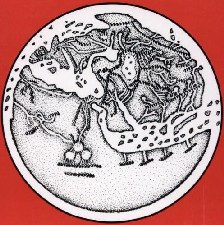
To next page
Sa'id al-Andalusi: Kitab Tabaqat al-'Umam (1029-1070)
(Book of the Categories of Nations) from Muslim Spain
-----------------------------------
The translation of : Categories of Nations; Ibn Said al Andalusi
Chapter 1: The Seven original Nations
The fourth nation was the Copts; they are the people of Egypt and the people of the South. They are the Sudanese [black people] from Abyssinia, Nubia, the Zinj, and others.
Also the people of the Maghrib [the West] and they are the Berbers and their neighbors to the west bordering on the Sea of Uqiyanus [Atlantic Ocean]. They spoke the same language and had one kingdom.
Chapter 2: The Two Categories of Nations
The group that showed no interest in science is comprised of all the remaining 'umam [nations] that were not previously mentioned. This includes the Chinese, Hajfij and Majuj [Gog and Magog], the Turks, the Burtas, the Sarirs, the Khazars, the Gilans, the Tilsans, the Murqans, the Kazakhs, the Alains, the Slavonians, the Bulgarians, the Russians, the Burjans, the Berbers, and the various people of Sudan, including the Ethiopians, the Nubians, the Zinj, and the Ghanaians, as well as others."
Chapter 3: Nations Having No Interest in Science
Also in this category are the people who lived close to the equinoctial line and behind it to the end of the populated world to the south. Because the sun remains close to their heads for long periods, their air and their climate have become hot: they are of hot temperament and fiery behavior. Their color turned black, and their hair turned kinky.
As a result, they lost the value of patience and firmness of perception. They were overcome by foolishness and ignorance. These are the people of Sudan who inhabited the far reaches of Ethiopia, Nubia, the Zinj, and others........
The only peoples that reject these humane institutions (governed by royal decrees and divine laws) and live outside these rational laws are a few of the inhabitants of the deserts and the wilderness such as the beggars of Bajah [Boga], the savages of Ghana, the misers of the Zinj, and those resembling them.
Chapter 5 : Science in India
The Indians .... are the essence of wisdom, the source of fairness and objectivity... sublime pensiveness, universal apologues, and useful and rare inventions. In spite of the fact that their color is in the first stage of blackness, which puts them in the same category as the blacks.... (They) enjoy the purity of talent and the power of distinction, making them totally different from the people of Sudan (Blacks) such as the Zinj, the Abyssinians, the Ethiopians and others.
Chapter 6 : Science in Egypt
Egypt in longitude stretches from Barka in the south of the Mediterranean up to Aila on the coastal plains of the sea arm that detaches from the sea of Abyssinien , of Zang, of India and of China......
Chapter 7 on Arabia
The land of the Arabs is known as the Arabian peninsula, this because of the sea that touches it from three sides. In the west it is bordered by a gulf on the coastal plains where is Gidda (Djedda), al-Gar, Aila, al-Kulzum and which detaches from the immense ocean (made up of) the sea of Zang and the one of India.